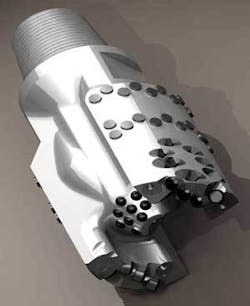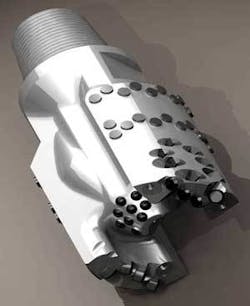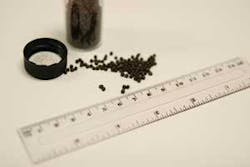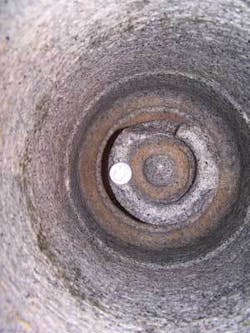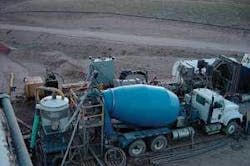Houston-based Particle Drilling Technologies Inc. has successfully tested a new drilling system, designed to enhance the rate of penetration through hard rock.
Particle-impact drilling (PID) is a closed-loop process in which hardened steel shot particles are injected into the drilling mud, circulated, and recovered from the mud system without allowing the shot to circulate through a rig’s pumps and surface equipment. The process operates under normal rig pump pressures, and the particles entrained with the drilling fluid are accelerated through the nozzles in a specially designed fixed-cutter drillbit (Fig. 1).
Conventional drillbits crush and grind rock, but PID does not rely on weight-on-bit and torque to mechanically break the rock.
The PID drillbit combines minimal mechanical grinding with hydraulic blasting. It removes rock by blasting it with the hardened steel particles (50-55 Rc), which comprise about 2-3% of the drilling mud by volume and strike the rock more than 4 million times/min, according to PDTI (Fig. 2).
PDTI’s Greg Galloway told OGJ that the company is testing two bit sizes: 7 7/8 in. and 8½ in. He said that the existing design (pre-January 2007) cuts the majority of hole and leaves less than 1/8-in. outer portion of gauge that is removed with the PDC cutters (Fig. 3).
The new design uses particle impact rather than PDC cutters to cut all the way to gauge. Although this creates the potential for overgauging, he noted there is very little downside. Fig. 4 shows the bottomhole pattern drilled by the PID bit in a hole drilled to gauge.
The surface components of the PID system include:
- Particle-injection system, between the mud pump and standpipe.
- Particle processing (separation) and containment unit (for recycled steel particles).
The spherical steel particles are currently injected from a hopper with a hydraulic frac pump truck, downstream from the rig’s mud pumps (Fig. 5). After circulating back uphole, the steel shot is collected by a triple screen “shot process kit” located before the shale shakers. The kit is based on a SWECO round-top separator, and the third (final) screen is passed over a rotating magnet to attract and capture the steel particles.
PDTI Senior Vice-Pres. Tommy Hardisty told OGJ that PID functions with conventional mud systems, 10-10.5 lb mud weight, 30-35 yield point, and 15-17 plastic viscosity. Where a fluid loss-control additive is necessary, the PID system works best with fine calcium.
The PID system and components are further described by US Patents 6,386,300 B1 and 6,581,700 B2.
Hard formations
ProDrill Services Inc. (PSI) and others developed the particle-impact drilling system and tested it in 2003 at the Rocky Mountain Oilfield Testing Center in Natrona County, Wyo.
PDTI acquired the technology in January 2004 and has continued to test and refine the PID system in a variety of tough formations:
• In Utah, PDTI ran 12 full-scale test programs on several versions of the PID bit at TerraTek Inc., an independent drilling and completions laboratory acquired by Schlumberger in July 2006. TerraTek tested PID performance using shot rates of 12, 14, and 16.5 gpm and bit weights ranging from 5,000, 10,000, and 15,000 lb.
TerraTek ran the PID bits through the Sierra White granite, Carthage marble, Mancos shale, and Crab Orchard sandstone (June 2005).
• At the Gas Technology Institute’s Catoosa facility near Tulsa (www.gticatoosa.com), the particle-impact system drilled through intervals including the Arbuckle dolomite, Verdigris limestone, Misener sandstone, Fayetteville shale, Oswego limestone, Pink limestone, and Mississippi limestone, with rock strengths from 25,000-50,000 psi (July; October-November 2005).
Hardisty said that the PID system drilled through a hard stringer at Catoosa, well known as “the wall,” so smoothly that the drillers did not discern the changes in lithology.
Following the Catoosa testing, PDTI announced that it had retained Beeken TechQuest Ltd. to develop a more efficient and cost effective shot injector system.
PID was also tested in the Uinta basin, drilling the Lower Mesaverde section, mostly hard and abrasive sandstone with some shale.
Commercial trials
In 2006, PDTI ran three commercial trials of particle-impact drilling on rigs operated by Nabors Drilling USA LP and Frontier Drilling Inc.
The first three trials were run with Gasco Production Co., a subsidiary of Gasco Energy Inc., Englewood, Colo., in May, November, and December, drilling at the Riverbend prospect, just south of the Monument Butte field in the Uinta basin, northeast Utah.
The next trial is being planned for another operator drilling in East Texas.
At the Utah trials, the PID system was successfully deployed and integrated into the rig during the May test, through formations that conventional bits typically drilled at less than 6 fph.
In a company announcement, PDTI Pres. and CEO Jim B. Terry said that “instantaneous drilling rates demonstrated...proof of concept at a depth greater than 10,000 ft in a real world drilling environment.”
In the November test, Gasco used the PID system to drill a 92-ft interval in 7 hr. Subsequent conventional bits averaged 90 ft in each 24-hr period during the following 5 days. PDTI said the PID bit was in good shape after 43 hr drilling and circulating, including 12 hr drilling with steel particles.
In December, the PID system drilled a 120-ft interval through the lower Mesaverde sandstone in about 8 hr on-bottom drilling time. The system was being tested on a new Frontier Drilling rig, in subfreezing temperatures and high winds, and still resulted in a record continuous drilling run.
PDTI said it worked through several mechanical failures of surface equipment during the trials. During the first commercial trial in May, the particle-recovery unit failed. During the third commercial trial, a particle storage drum’s drive line failed, but PDTI was able to repair it with replacement parts.
US markets
The harder the rock, the slower it drills, and the slower it drills, the more the well costs. Slow drilling through a hard section can disproportionately affect the cost of a well and render deep gas exploitation uneconomic. PDTI estimates that about half of all onshore, vertical gas wells encounter hard rock intervals.
In a presentation to investors in December 2006, PDTI said its technology may be most useful in wells that take more than 30 days to drill. The company examined the number of drilling days in three active regions for the 12-month period, September 2004-September 2005:
- Rockies, 46,121 days.
- Midcontinent, 24,015 days.
- Permian basin, 22,270 days.
Hardisty told OGJ that operators in the Uinta basin are concerned with drilling the Mesaverde, Castlegate, Blackhawk, Maury, and Dakota sandstones, among others.
In the Green River basin, there’s difficult drilling below the Upper Cretaceous section; tough formations through and below the lower Mesa Verde. Hardisty also noted Chevron USA Inc.’s drilling through the Almond and Nugget formations in the Table Rock Unit, in Wyoming and some other areas of the Green River basin.
Houston-based Ultra Petroleum Corp., Salt Lake City’s Questar Corp., and others have attempted some deep drilling at Pinedale.
Future
Improving drilling performance can reduce well cost. Reducing drilling costs may render more reserves economic.
Last month, PDTI announced a 1-year gain-sharing contract with operator Gasco to use particle-impact drilling. The oil field services firm is building a second PID system, at an estimated cost of $1.6 million, to be finished in first-quarter 2007. The expected payback period for the second PID unit is about 8 months.
The company said subsequent systems should run about $600,000, with a shorter payback period. Terry told OGJ that PDTI is planning to have 10 sets of equipment available by the end of 2007, including injection and extraction equipment and bits.
PDTI says it will continue to improve the hardware and operating processes. Hardisty told OGJ that the company is refining the bit, adjusting nozzle configuration to be more robust and for drilling to gauge.
It will also test and deploy new injectors in 2007. The prototype of the extruder injection system was built and tested in the UK in December 2006, shipped to the US, and was being tested in PDTI’s Houston research center in January 2007.
In a recent company announcement, Terry said PDTI would begin field trials using the new injection system in parallel with the existing injector, following successful testing (www.particledrilling.com).
It will also be very interesting to see whether the system will aid drilling through dense basalt. OGJ expects a ramp-up of activity in Washington’s Columbia River basin that may provide opportunities to further test particle-impact drilling.
